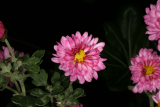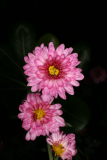Additional notes (click to expand)
Horticulture
This attractive, pink cultivar is the product of it's parent plant, Chrysanthemum morifolium. They are called Florists' Chrysanthemums. They consist of ray-florets with yellow disc-florets in the centre.
Take basal cuttings from over-wintered stools in early spring. Root cuttings in loamless potting compost with dry sand on the surface, at around 16°C. Place in a cold frame after first potting; protect from frost and ventilate as weather allows.
Pest and diseases: vulnerable to aphids, weawigs, eelworms, capsid bugs, leaf miners, red spider mites, and white-flies. Prone to fungal rot, grey mould, powdery mildew and white rust. Viruses can cause stunting, yellow markings and puckering of leaves.
Brickell, C. (2003). A-Z Encyclopedia of Garden Plants. Dorling Kindersley. p.215
Medicinal
In China it's called ju hua. Chrsyanthemum morifolium flowers have been boiled in water to create a refreshing tea to stimulate blood circulation, improve vision, soothe sore eyes, relieve headaches, counter infections and treat hypertension, chronic inflammation, dizziness, cold, coronary heart diseases and angina. Decoction of flowers is used to promote menstruation, as a wash for infected and cancerous sores and carbuncles and as a poultice for enlarged glands. Flowers soaked in wine are used to restore vital functions for a variety of digestive, circulatory and nervous problems. Decoction of flowers and leaves is used for stomachache and as an enema. Leaf juice is smeared on wounds. Chrysanthemum sibiricum and C. sinense are also used for cancerous sores, mammary carcinoma and tumours.
Channels Affected: Lung and Liver.
Actions: Clears heat. For a cold with fever, headache, red eyes.
Calms the Liver. For temporal headaches, dry, red or itchy eyes.
Lim, T.K. (2013). Edible And Non-Medicinal Plants, Volume 7, Flowers. Springer. p.264
Nomenclature
From two Greek words, 'chrysos' meaning golden and 'anthos' meaning flower. The beautiful flowers bloom in autumn and come in many different colors, including red, orange, white, yellow and lavender. First introduced to the West by the Chinese in the eighteenth century, these flowers have rapidly become popular as ornamental decorations. In the East, they have been used in traditional medicine since at least the first century A.D.
Other use
Cultivated varieties of Chrysanthemum come in different colours and sizes and have been grown as an ornamental or cut flower for thousands of years.
Geographical distribution
- Asia-Temperate, China, China North-Central
- Asia-Temperate, China, China South-Central
- Asia-Temperate, China, China Southeast
Chrysanthemum 'Anastasia'
Family: ASTERACEAEGenus: Chrysanthemum
Species:
Cultivar: 'Anastasia'
Habit: Perennial
Hardiness: H5 - Hardy; cold winter
Garden status: Not currently grown
Flowering months: October, November

.JPG)
.JPG)
.JPG)
.JPG)
.JPG)
